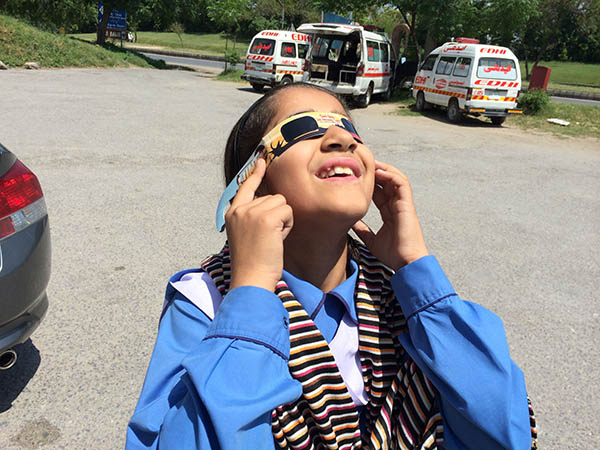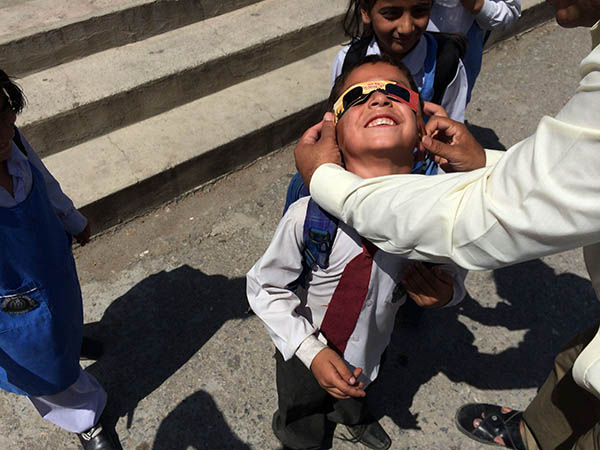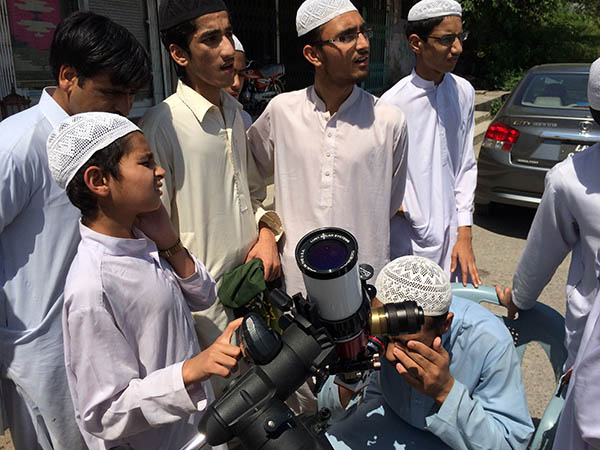Recently attached my new Canon 6D with CBSAP triplet 127mm Refractor telescope and took a single shot image of the Moon. Processed it in Photoshop and it turned out nicely sharped and exposed.
Solar outreach - LGS Astronomy Society
Students of Lahore Grammar School, Johar Town Branch, visited the observatory a few days ago. First i gave them an introductory presentation about the observatory which was followed by a tour of the building, the main telescope it has, Celestron C14 with all its extra gear and the adjacent 'Human Room'.
Fortunately the sky was clear and we first setup Celestron CGEM DX mount, mounted Lunt 152mm Halpha telescope on it, adjusted the pressure tuner, focuser and looked into the eyepiece. There it were.. a few but beautiful Solar Prominences. Lunt152 is an amazing instrument to see the Sun's lower atmosphere. With its big aperture, the details in the view are unforgetable indeed!
Nothing comes close to a white light telescope setup to see the surface of the Sun, where Sunspots and Granulation can be seen at their best. CBSAP 127mm refractor with Herschel Wedge is such an out of this world combination for observing solar surface... Unfortunately, there were very few and small Sunspots at that day; Nonetheless, these young minds were intrigued by looking 'directly' at the Sun and asked many many interesting questions.
I am thankful to their Science teacher Shaista Irfan, who planned and organized it all. I am sure many more students of this school will be coming here after their exams.
Hamari Kainaat (Urdu) - Episode 3
Last month, in January 2015, a triple transit occurred on Jupiter. A transit can happen on Jupiter once in a week or so but the next triple transit will be not before 2032!
What is it? How and why it happens? What is the importance of Planet Jupiter in our Solar System? These are some of the questions we try to answer in this episode of Hamari Kainaat. So let's listen to it!
Large Filament on Sun today
Lunt 152mm Hydrogen Alpha Telescope
DMK 21 Camera
Televue 2.5X
Autostakkert
Registax
Photoshop CS5
Lecture by Dr Salman Hameed
This lecture was given in at the end of December 2014 here at Zeds Astronomical Observatory. We had a good gathering in the cold evening. The lecture (in Urdu) was about the efforts we humans have done to know about the Universe and how it has shaped our understanding of who we are. I am sure you would all enjoy it.
'Hamari Kainaat' an Astronomy Podcast in Urdu
Astronomy is becoming more and more popular in Pakistan, specially in Lahore and Karachi. In Karachi city, Karachi Amateur Society is doing a really good job to popularize it among the students, general public and of course among there members. They have a beautiful observatory with very fine instruments!
Amateur Astronomers also formed an Astronomy society in Peshawar recently and i have skyped with them once, thanks to the great efforts of Khalid Marwat.
In my own city, Lahore, we have a very active group and so many enthusiastic members who run Lahore Astronomical Society. We regularly hold a monthly meeting at Zeds Astronomical Observatory, where one of our members delivers a keynote presentation, which follows by a very active Q/A session. Workshops are also conducted here so amateurs at all levels can benefit with others' skills.
My observatory also host public star and Sun gazing sessions. We have many telescopes of all kinds and sizes to see what's up there.
Dr Salman Hameed and i were planning to start a podcast in Urdu for Astronomy outreach in Pakistan. This dream has finally been realized now! Anyone who has an internet connection can listen and enjoy. Here is our first episode of 'Hamari Kainaat'!
Asteroid 139 Juewa video
This is from last night. This asteroid is from main belt and was first discovered in China by an American Astronomer in 19th century.
These images were taken from 12:18 - 12:58 yesterday night. There are total of 40 frames, here running at 10 frames per second. Each frame is of 30 seconds exposure in Astrodon V filter.
My back on the hand calculation says, it is moving at about 400 km/sec..Thats fast! Is that right?
Equipment: Celestron C14 Telescope
Mount: Losmandy Titan
Camera: SBIG ST9XE CCD Camera, internally guided
Software: FocusMax, MaximDL, Pinpoint, SkyX Pro
Here is a stacked image of all these ~ 40 frames. The streak is the path it took while imaging.
LPOD October 9, 2014
This image of mine was selected for "Lunar Photo of the Day' on October 9, 2014. More details are here.
Some Lunar Images
Telescope: CBSAP 127 APO Triplet
CCD Camera: DMK21 mono
Mount: Celetsron CGEM DX
Solar Prominence - 19 Oct 2014
Here is a huge prominence visible at the edge of the sun. Compare it with the size of the Planet Earth! This prominence is solar plasma being held by the loops of complicated structure of solar magnetic fields.
AAVSO Data Submissions
I have started submitting variable stars' data to AAVSO (American Association of Variable Star Observers), the largest group for variable star observers in the world; it has more than 20 million observations and counting.
This image is the screen shot of my submission report on AAVSO homepage. So happy to see 'PK' there at the website :)
The equipment and softwares i am using are as follows:
Telescope: Celestron C14
Mount: Losmandy Titan
CCD Camera: SBIG ST9XE
Filter Wheel: SBIG CFW-8
Focuser: TCF
Filter: Astrodon Photometric V Filter
Softwares: Maxim DL and Maxpoint
'X class' Solar Flare
Sunspot 2192 got flared up with an X-class flare this Sunday. I received a notification of this flare on my iphone app 'Solar Monitor' when i was about to put Lunt 152 Solar Telescope on CGEM DX mount. My excitement got flared up as well!
Solar flares are the explosions on the sun, which can cause disturbances here on earth. X-class is a a very big explosion which can initiate radio blackouts on the sun facing side of earth. This was a X1-class solar flare.
Planetary Nebula- NGC 7026
This is a view in the Cygnus, the swan, constellation. The view here is almost 9*9 arc minutes, 3.5 times smaller than the full moon in the sky. This is the field of view of Celestron C14 telescope and SBIG ST9XE CCD camera; TCF focuser and a SBIG CFW8 filter wheel is placed in between them.
At one o clock in the image, there is a seemingly double star like object with some very faint nebulosity around it. Let me introduce:
Friends meet dead star.. dead star meet friends!
NGC 7026 is the closest astronomers could get to name it as poetically as they could (NGC stands for 'New General Catalogue'). This designation is of a star who died a thousand or a bit more years ago (exact date is uncertain) and lost its out layers into the interstellar space. These objects are called 'Planetary Nebulae'. The gas a star loses in its last stage of its death, keeps on becoming thinner and harder to see and in about 10,000 years or so, it becomes invisible mixing up with the interstellar medium.
The location of NGC 7026 is already in a bad place for us to observe. It is in the milkyway (most Planetary Nebula (PN) are because there the most stars live) so light loss (interstellar extinction) must be happening severely. And talk about my beloved city, Lahore, where i reach my sky-limit even before i open the telescope! (okay... that is not so true.. it takes a few minutes). When it comes to deep sky imaging, i am up against all the odds. But nevertheless, i did try to image this PN with a luminance filter. It has two bright lobes, very bright.. so capturing the nebulosity in the surroundings seemed harder. With a few test exposures, i settled on 4 minutes of sub-exposures. It seemed to give me enough light for capturing the nebulosity and not overexposing the bright lobes, i did however got a little bit of bloom in the neighboring star but that was not an issue for me.
Two nights and a total of 4.8 hours of luminance data. Calibrated carefully with a lot of Bias, Dark and Flat frames. Here is the magnified and resized image of this PN:
This PN has a complex lobed structure and many studies have shown a lot of intricate pattern in the nebulosity. See here and here and this talks about the central star in NGC 7026.
I found an image from H D Curtis of Shapley-Curtis Great Debate fame; this image is some 100 years old. Now compare it with my image:
okay so my image is not so clear.. remember: i live in Lahore!
So after a 100 years, we must expect some changes in the nebula's extending nebulosity... hmm.. what has changed here.. want to take a minute to compare?
Maxim DL provides a nice tool in 'Graph Window', called 'Area Plot'. This shows a 3D view of a particular user selected area in terms of brightness indication and the location.
See the two bright lobes are peaking in the intensity, changing colour from blue (sky background which is supposed to be dark but here the value is in a few thousands!) to red the brightest. Notice the nebulosity is also visible as small bumps in the background sky. Actually the dimmest nebulosity here in my image is just about 1.3 times the brightness of the background sky. Yes i was using LP filter, Hutech LPS2.
What else can i do with this image? hmm.. oh yes.. let's measure the size of this PN. So my image scale with my current setup is 1.045 arcseconds per pixel. I again used Maxim DL to show me the size of the nebulosity in pixel counts.
The line graph shown the intensity at each individual pixel and the total pixels the line has covered. They are about 40. So the line is covering 40 * 1.045 = 41.8 arcseconds.
If the distance of the nebula is 2000 parsac then using the ABC formula in astronomy, the small angle formula, the size of the nebula is 1.3 light years, which is a typical size of a planetary nebula.
Oh and this is what hubble space telescope could image in this PN.
SkyWatcher Dob 10 inch
I have started selling astronomical telescopes here in lahore! This was one of my big astro dream that people should be able to buy telescope within pakistan. As far as i know, Karachi and Lahore are the only two cities which are providing astronomical telescopes for sale now.
I had never used a skywatcher telescope before and i was keen to open up a box, any box and the one i opened was a 10 inch manual dobsonian.
Assembly was easy and quick. The telescope looked very nice.
At night i saw moon with it and the contrast was amazing indeed. Skywatcher produce very nice products! Here is the moon image i took with my cell phone, single frame no enhancements.
'Jon Wood' Award 2014
"The Jon Wood Award recognizes those that excel in the field of public astronomy outreach and/or display a keen potential in the sciences. This award is given out generally five times per year by 'Charlie Bates Solar Astronomy Project' to assist and encourage solar astronomers around the world to begin or increase their solar astronomy outreach activities int heir local communities"
On 30 May, 2014, I got this announcement from the director Stephen W. Ramsden of 'Charlie Bates Solar Astronomy Project':
"The next recipient of CBSAP equipment to help their outreach efforts will be Umair Asim in Pakistan. Umair personifies all the values of our program and he has a passion for improving his community through science that is unrivaled, in my experience."
I was pleasantly surprised to hear that! I am so grateful to CBSAP for this honour! CBSAP sends solar astronomy equipment with this award and on 3 July, this was announced:
"I am EXTREMELY proud to announce that thanks to the donors to this program and my recent award of a new scope and the Astro-Oscar at the Starlight Festival we at CBSAP headquarters have just shipped off another Jon Wood Outreach Award to a most deserving individual in Lahore, Pakistan. Congratulations Umair Asim at the Farooqi Girls High School for his tireless efforts at educating students and the general public about the wonders and science of Astronomy! ... together we have all made it happen through our combined financial support and my extra equipment! He has just been shipped:
Meade 127mm APO with Feather Touch Custom Focuser
Lunt Solar Systems 2 inch Wedge
2 sets of Polarizers 2 inch and 1.25 inch
Baader Hyperion 8-24mm MkIII Zoom lens eyepiece
Televue 2.5x Powermate
Skywatcher 2 inch Nighttime Star Diagonal
Explore Scientific 50mm Finder Scope
ADM mounting rings and a Vixen rail
Retail value over $5000!! plus $1200 to ship it!"
WOW!!! I was simply overjoyed to see all this :)
The equipment reached to me in the third week of July. Though it was requested, at all four sides of the package, to the customs to wave the duty and other charges since this equipment will be used for public outreach and astronomy program but i ran out of luck there.. anyway after the clearance, i was there to receive it from UPS Courier.
The package was Huge!! and putting it in my car was not possible so i had to use non conventional way of driving.. yes yes.. Safety First.. for telescope.. right!
Thank you once again CBSAP and Stephen Ramsden! Just waiting and hoping for the monsoon season to end up soon and then there will be me, this telescope and all, lots of young students and the star of our show, the Mighty Sun!
Solar Outreach - Govt Girls High School
I was invited for a solar observation session, by RABTT society who is very active in reforming traditional educational routines in the lives of school children. Today i went to Government Comprehensive Girls High School which is located at Wahdat Road, Lahore.
I first distributed the solar glasses to all the students and talked briefly about how to view to sun safely. They were all so very excited about actually looking at the sun with the solar scope that they wanted me to skip the words and go outside to watch the sun.
With the Lunt60 telescope and Lunt zoom eyepiece, they saw the sun in its full glory.. a big prominence, some smaller ones and a couple of sunspots near a big filament. I have rarely seen the excitment they were having on their faces.
Thanks RABTT for this wonderful oppertunity to show the sun to these students.
Oh and in the end, one of my new friends and my fellow TEDx UET speaker Omer Najam appeared from nowhere! Good to see you janab!
Solar Observation for Madrassa Students
This was one of the most memorable outreach session for me. The students of a Madrassa literally came running to the solar telescope as soon as they saw an odd looking machine near their mosque.
First i gave them the solar glasses. Now just look at them smiling with these on their faces :) I gave them all the glasses i had in my car and requested to take these to their homes and show their class fellows, siblings and parents. Next they saw the sun through the halpha telescope. Everyone just glued himself with the eyepiece; i was requesting for others' right to see the sun.
Nothing was planned there. I actually went to see my friend and when we ordered the food, the thought came to my mind. There is a Madrassa right there so why not show the kids the wonders of the universe. Wherever i go, my halpha telescope is always in my car trunk. So there i was, showing them the 'fire' on the sun and how much they got excited is beyond the words i can write.
Another solar outreach.. another happy day :)
IST Solar observation
Solar Observation session at Institute of Space Technology, Islamabad.
Prominence - 25 May 2014
Pores and Granulation - 19 May 2014
How many 'pores' can you see here? (Pores are the black spots which is an early stage of a sunspot evolution)
Telescope: Lunt152
Camera: DMK21AU04
Televue 2.5X
19 May 2014
Lahore, Pakistan.






















































